Tulips are beautiful flowers that cheer your garden with bright and vibrant colors every spring. Whether a novice or an experienced gardener, caring for tulips is very easy. They will bloom the whole spring profusely with a bit of care and attention.
However, even with good knowledge, you can make mistakes that can result in severe issues in tulips. So, in this article, we shall learn how to care for the tulip plant in the right way.
Tulips will require full sun for 8-10 hours daily, well-drained and organic-rich soil, and temperatures ranging between 30-55°F. Water the tulips once a week to keep the soil bed moist and fertilize them only once or twice a year to help them grow. Also, keep an eye out for pests and diseases.
There is a lot more you need to know about tulips. If you ever desire to grow tulips, this guide has every detail about growing a healthy tulip plant. We will explain all the basic needs, typical and expected issues, and ways of treating them.

Tulips: An overview
Tulips originated from an Old Persian word, “Tulipan,” which means turbans. The laborers in the tulip fields adorned their turbans with flowers. In their culture, tulip flowers were considered the flower of God.
Tulips originated from the Ottoman Empire, now known as Turkey. Tulips were regarded as a sign of power and wealth in the Ottoman Empire.
In today’s date, tulips are the national flowers of the Netherlands and the national flower of Turkey. In the 17th century, tulips became a symbol of wealth for the Dutch.
In the present day, the symbolism of tulips has changed into a sign of love. But, it is not the same for all. Tulips have many colors, and different colors have different symbols, like joy, charity, royalty, rebirth, or purity.
The sizes of the tulips are pretty distinctive, depending on the variety.
The Single Early variety grows up to 15 cm, whereas the Darwin hybrids and Single Late varieties will grow up to 70cm.
The flowers are large and radial in shape. They have 3 sepals and petals, respectively, comparable in color and oval shape.
Is tulip easy to grow?
Yes, tulips are low-maintenance plants and very easy to grow. They need 1-inch water once a week and thrive when planted in a site with plenty of sunlight throughout the day.
Your tulips are bound to bloom every spring year after year with the essential requirements.
Are tulips indoor or outdoor plants?
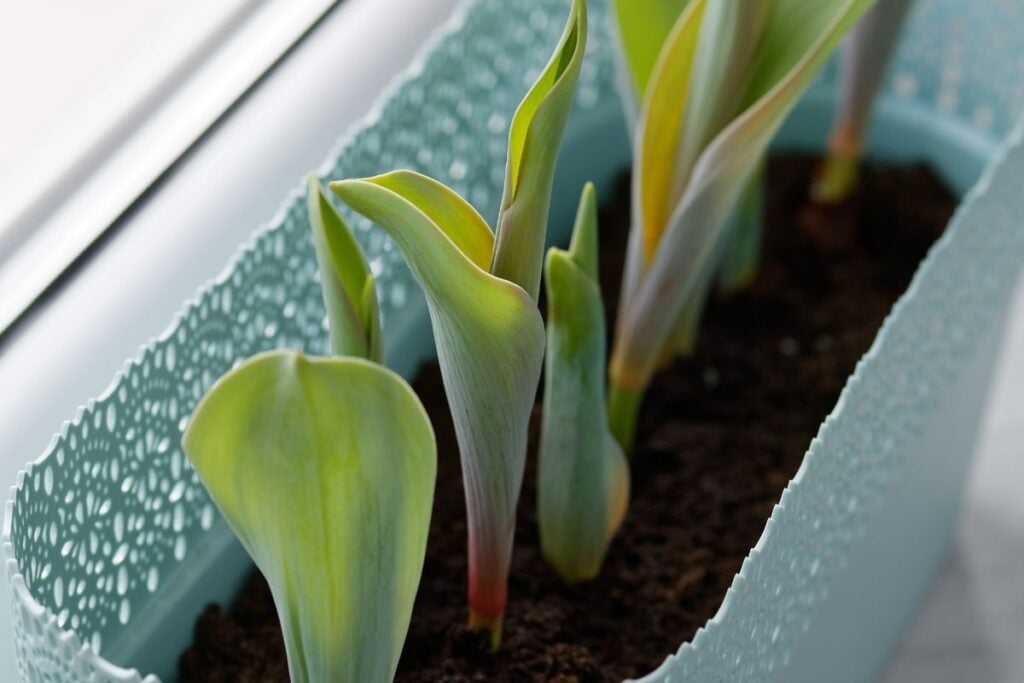
Traditionally, tulips are outdoor plants that grow best when planted in the ground or raised beds. They thrive with minimal care and attention.
They will require little protection during strong winds, hail, and extreme temperatures, like shelter.
If you want, you can grow them indoors too. But, indoors, the tulips are kind of forced to grow and flower. As a result, the potted tulips might not flower next year.
But, with an adequate amount of care and management, potted tulips can also be kept alive for years. It entirely depends upon your way of taking care of them.
Also read: Are Tulips Inside Or Outside Plants?
Types of tulips
Over 500 types and varieties of tulips have been found. So, you always have the choice to own the tulip that attracts and appeals to you. Below, I have shared some of the varieties:
Parrot tulips
These tulips have got their name from the petals. Their blooms are cup-shaped and fringed. Parrot tulips come in orange, pink, red, and double-toned colors.
Parrot tulips will grow big enough, and their blooms are 5 inches. Their stems grow at a height of around 12 to 26 inches.
Triumph tulips
These tulips have a vast group. This variety has its signature cup shape. They even harbor the strength of Darwin’s hybrids. Even though they are smaller than the Darwins, they can easily tolerate winds and rains.
Triumph tulips have a lot of beautiful colors, like pink, white, peach, purple, and even combinations.
Darwin hybrid tulips
Darwin hybrids are the hardy ones. If you want hardy tulips grown annually, these hybrids are the best choice. They have a lot of warm and radiant colors, like red, orange, yellow, pink, etc.
Darwin hybrids will grow around 2 feet taller. They can tolerate frozen winters, winds, and rains as hardy plants.
Many hybrids cannot be grown as perennials because, being hybrids, they lose their ability to come back. But, Darwin hybrids can be perennials.
Looking for gardening supplies? We have tested 100's of products before recommending them to you guys. Check out our best pick below:
| Image | Gardening Supplies | Best Price? |
|---|---|---|
 Top
Top Top
Top | Raised Garden Bed Kit | Check On Amazon |
 | XLUX Soil Moisture Meter, Plant Water Monitor, Soil Hygrometer Sensor for Gardening, Farming, Indoor and Outdoor Plants, No Batteries Required | No Results |
 Top
Top Top
Top | 82 Pcs Garden Tools Set and Extra Succulent Tools Set | Check On Amazon |
 | Joeys Garden Expandable Garden Hose with 8 Function Hose Nozzle, Lightweight Anti-Kink Flexible Garden Hoses, Extra Strength Fabric with Double Latex Core, (50 FT, Black) | No Results |
 Top
Top Top
Top | Dual Chamber Compost Tumbler | Check On Amazon |
 Top
Top Top
Top | Sunnyglade Plant Stakes | Check On Amazon |
 Top
Top Top
Top | Organic Cold Pressed Neem Seed Oil | Check On Amazon |
 Top
Top Top
Top | Mighty Mint Gallon :-Insect and Pest Control Peppermint Oil | Check On Amazon |
 Top
Top Top
Top | Scotts DiseaseEx Lawn Fungicide | Check On Amazon |
 Top
Top Top
Top | Jacks Classic 20-20-20 All Purpose Fertilizer | Check On Amazon |
 Top
Top Top
Top | 30,000 Seeds Pollinator Attracting Wildflower Mixture | Check On Amazon |
 Top
Top Top
Top | Survival Vegetable Seeds Garden Kit-Over 16,000 Seeds | Check On Amazon |
Species tulips
These are non-hybrids and true perennials coming back year after year. Species tulips will add a distinctive look to your garden. They come in mostly reds and yellows, and blue, pink, and white.
They are a little smaller in size. Species tulips will grow between 4 to 12 inches in height. They grow well in rocky soil.
When and where to plant tulips?
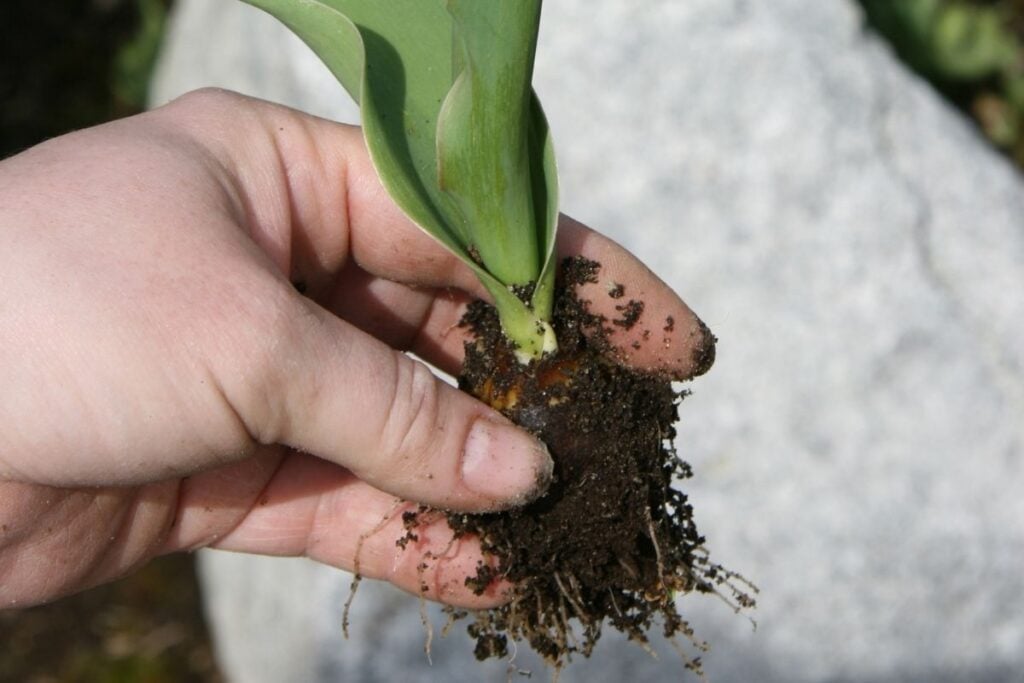
Generally, tulips are planted in USDA zones 7 and below during the fall. Plant the tulips bulbs during December or January to enjoy a colorful spring if you live in a region where the hardiness zones are 8 or above.
The bulbs will require chilling at 40-45°F for 10 to 12 weeks. You must plant tulips in a site where they will receive plenty of sunlight.
The planting site’s soil must be well-drained with a pH level between 6 and 7. While planting, maintain a 4 to 6 inches distance between each bulb. This will give them enough space to multiply and dodge overcrowding.
You should plant tulips about 6 to 8 inches deep. Planting 12 inches deep may save them from strong wind or heavy rain but will make them sprout late.
Position the bulbs properly and place the pointed side upwards. Cover the bulbs with 6-8 inches of soil, mixed with compost or bulb fertilizer. This will keep the bulbs healthy and devoid of any nutrient deficiency.
Press the soil gently to remove any air pockets. Water them thoroughly. Watering will send them a signal of the right time to sprout out from the ground.
Also read: When’s The Best Time To Plant Tulips? (+After Plant Care)
Tulips care guide
Maintaining them will become effortless once you are acquainted with tulips’ necessities and growing conditions. With less attention than other plants, your tulips will thrive and flower each spring.
Tulips have a unique feature – they open in the day and close at night. This is called nyctinasty.
It is common to make errors at some point, especially if you are gullible about tulips. But this guide will help you bypass common mistakes like incorrect watering, over-fertilizing, or planting at an improper depth.
In this article, I have addressed all the major and minor details about caring tulips that will assist you in growing healthy and long-lasting tulips.
Light requirements
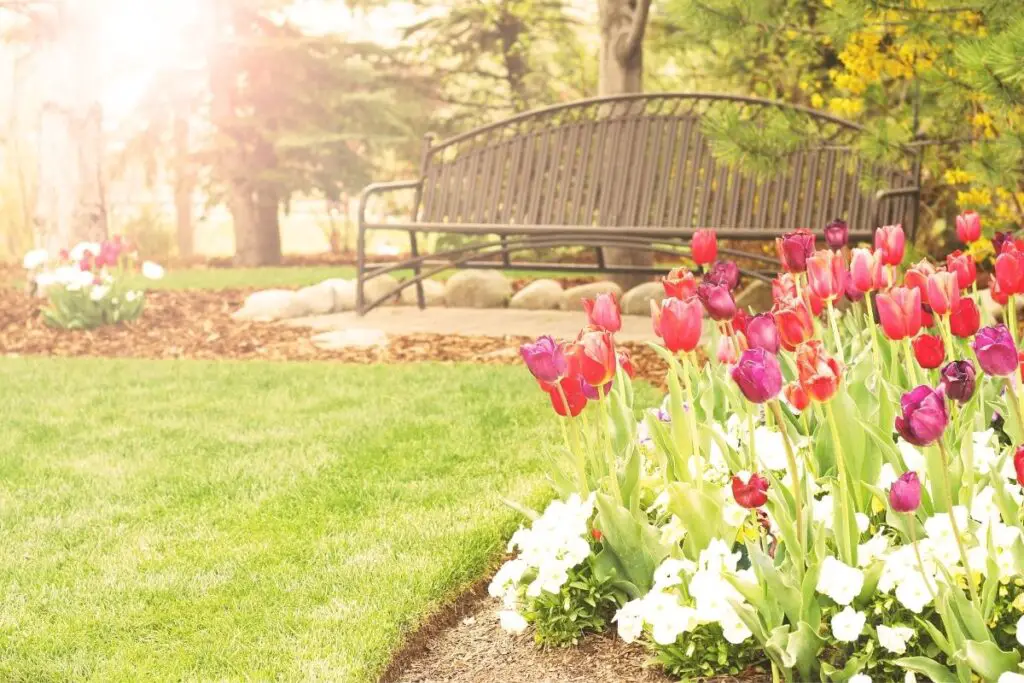
Tulips like to receive full sun for 8-10 hours daily. A good amount of sunlight will give the plants enough energy for photosynthesis and add colors to the flowers.
You need to select a planting site with an adequate amount of light. It is not mandatory to receive it constantly. Receiving full sunlight at separate periods, summing up to six hours, will work great.
During harsh sunlight, partial shade in the tulip bed will help them bloom better. This will keep the flowers from fading, help the bulbs to mature better, and gather the energy needed for the following year’s blooming.
If you have planted them in a northern direction, full sun will be best for them. If they are planted in the southern direction, the partial shade will help them to thrive.
Also read: How Much Sunlight Do Tulips Need? (Tulip Light Needs)
Soil requirements

Tulips enjoy growing in well-drained and fertile soil, with an ideal pH level and soil temperature.
Tulips will thrive in porous soil holding a lot of organic ingredients. Adding organic ingredients to the soil bed will improve soil fertility.
Tulips will not like prolonged wet soil. To improve drainage, you can add a 1-inch layer of mulch or sand to the bed. Use organic mulch like shredded pine bark. This mulch will, later on, break down to mix in the soil, making the soil more fertile.
One more way to improve the drainage of the tulip soil is to plant them in a raised bed. Raised beds help to drain water faster than the ground.
You should plant the bulbs in the fall when the soil temperature ranges below 60°F. This temperature helps the bulbs to remain in hibernation.
Adding 2-3 inches of mulch to the soil bed will protect them from harsh temperatures.
Tulips require soil pH levels ranging from 6.0 to 7.0. If you are unsure about soil pH, use a testing kit to confirm.
If the soil gets a low pH level, increase it by adding wood ash or limestone powder.
If the soil contains a high pH level, add acidic mulches like peat moss, animal manure, shredded oak leaves, and pine needles to adjust the pH level.
Also read: What Kind Of Soil Is Good For Tulips? (Best Soil Mix)
Water requirements
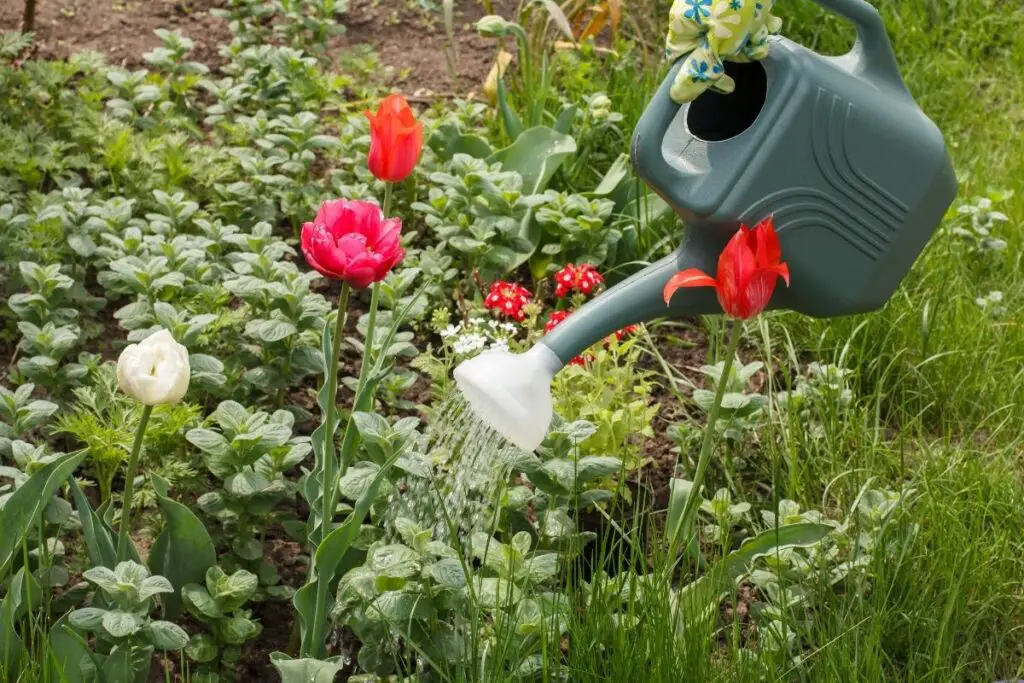
Tulips don’t need frequent watering. They need less water compared to many plants. Every week, the tulips will require 1 inch of water to remain evenly moist.
During the summers, they remain dormant. Where most plants need more watering in summers, tulips don’t need water.
When tulips are actively growing in the months of spring, their water requirements will count on the temperature and rain frequency. During days of constant rain, skip watering until the soil gets dry.
In dry climates, water them every 4-5 weeks.
To follow a perfect timetable, check the moisture level of the soil bed. Water the tulips again when the top 1 inch of the soil bed gets dry.
Tulips will always benefit from deep watering. The water needs to reach the bulbs, signaling them to grow and flower.
Watering, however, depends on many factors. If the soil is very light and the water dries too fast, they will need watering twice a week.
If the soil is not draining water well, you have to wait for at least 10 days to let them dry out. You can add compost, mulch, or sand to improve draining.
Overwatering can rot the bulbs and stop the plant from growing or flowering.
After planting, water the bulbs thoroughly. Wait until spring to water again. Water the bed to keep the soil slightly moist during the extended dry period.
When the tulips flowers die, you can reduce the watering to ½ inch to keep the leaves healthy until they die naturally.
Also read: How Often Do Tulips Need To Be Watered? (Tulip Watering Needs )
Temperature tolerance
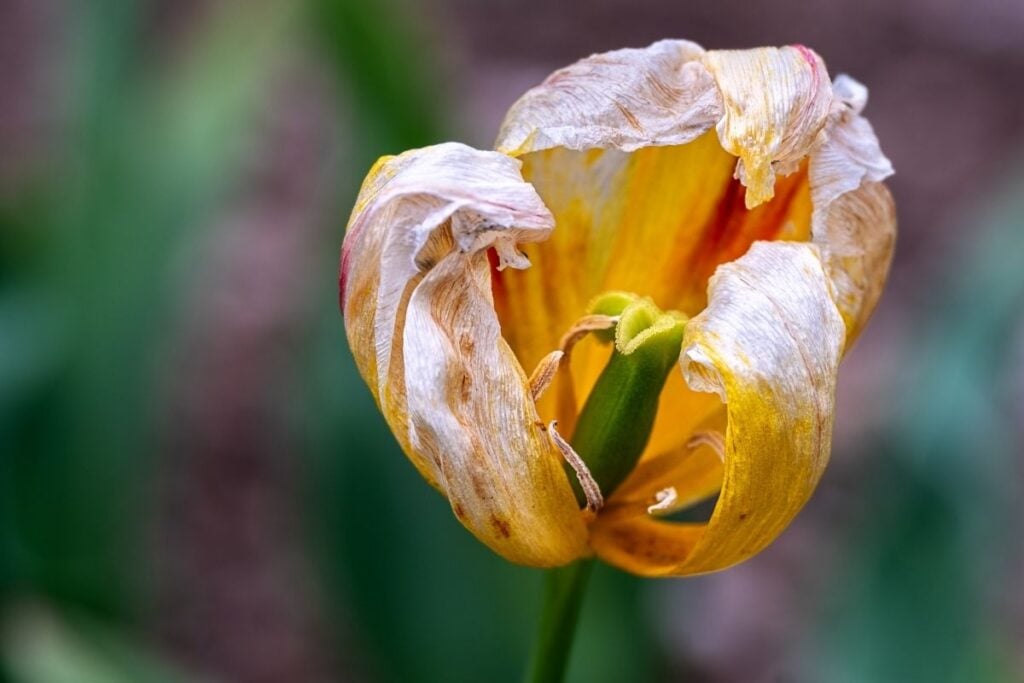
Tulips love winters and remain dormant in summers. An ideal temperature required for tulips should range from 30 to 55°F or 60°F.
Temperature rising above 73°F and dropping below 29°F is not suitable for them. Even if they tolerate some at 70°F, they will not bear any flowers.
In their natural habitat, tulips get to cool down gradually for 6 to 12 weeks during winter. The temperature starts dropping from 50°F to 40°F within 6 to 8 weeks.
Once the winter reaches its end, the temperature again starts rising to 50-55°F within 4 to 6 weeks.
The tulips have sprouted by now. They will bloom for 4 to 5 weeks when the temperature remains constant around them, around 60°F.
Now, what will you do if your region doesn’t get this long chilly winter climate? This is most likely to happen in zones 8 or above. Don’t worry.
You can fool the bulbs by storing them in your refrigerator for a couple of weeks. Store the tulip bulbs in a paper or mesh bag in the fridge and away from fruits. The ethylene gas from fruits can damage them. Plant them during the cold months.
Also read: What Temperature Do Tulips Need? (+Growing Them At Different Temperature)
Fertilization

Tulips don’t need much fertilizer. Tulips need fertilizer only once or twice in one whole year.
Before planting, dig up the planting bed around 12 inches and add 1-inch compost in the soil. This will not only just help you to improve drainage but will fertilize the soil too.
Some growers don’t recommend fertilizing at the time of planting because the bulbs already hold a lot of nutrients. But using compost is okay because being organic won’t harm your tulip bulbs. Water the bed well after planting.
Fertilizing a little during the spring, when they grow new leaves, will help them develop and store a lot of food and energy to flower abundantly in the spring.
Use a balanced slow-release fertilizer. Apply 1 pound of it over a 50 square feet ground. Sprinkle on the ground but avoid the planting holes and the foliage.
Water the soil bed very well to distribute the nutrients evenly.
After the flowers die, the leaves are still green, capable of photosynthesis.
Fertilizing little with a nitrogen-based fertilizer will give the foliage energy, which the bulbs will further store for using it in the following spring blooming. Stop fertilizing once the leaves start turning yellow.
Some growers casually add bone meal to the soil bed while planting. But, bone meal is usually used to increase phosphorus levels. Unless your soil bed suffers from low phosphorus levels, staying away from a bone meal is better.
Also read: What Is The Best Fertilizer For Tulips? (Organic+Inorganic)
Tulips after-flowering care

Once the tulips complete their flowering cycle, the blooms will die. If you want the tulips to come back each year, you must remove the flowers to stop them from making seeds.
The bulbs take a lot of energy to make seeds, and they won’t flower the following year. By deadheading the spent blossoms, the bulbs will store this energy to flower again the following spring.
Once you pinch off the flower, let the leaves remain.
As I mentioned in the “Fertilizer” point, you can fertilize them a little with nitrogen-based fertilizer to help the leaves have more food and energy.
Allow the leaves to die naturally. When you see the leaves begin to turn yellow, stop fertilizing immediately. Wait until all the leaves die.
Remove the yellow leaves. If your region has a good cold in winter and your tulips’ growing conditions are excellent, let the bulbs remain in the ground. This will also encourage spreading.
But, if your region has hardiness zones 8 or above, dig up and store them in the cold and again replant them in the following fall.
Also read: What To Do With Tulips At The End Of The Season? (Dig Up, Store & Rebloom)
Digging up tulips
Generally, tulips don’t need to dig up each year unless your region gets enough cold. Tulips require digging up when the bulbs get overcrowded. You can dig up tulips every 3 to 4 years.
You will find new 4 to 5 baby bulbs attached with the main bulb when you do this. You need to divide them and plant them immediately at some distance away.
Also read: Do Tulips Need To Be Dug Up Every Year? (When+How)
Transplanting and replanting the bulbs
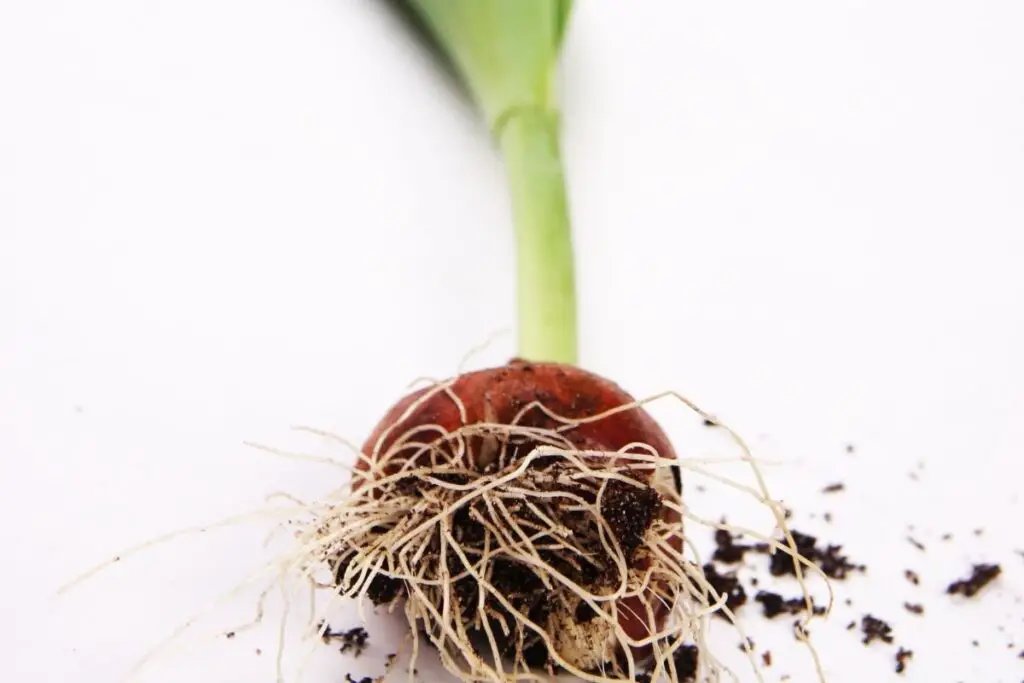
This is done after digging and dividing the bulbs. When the bulbs multiply, it gets overcrowded. You need to separate and transplant them to another place.
You can either plant the tulips in the same bed or some distance apart or create a new soil bed for them.
One solution is to plant some in the original bed and others in the new bed. If they don’t do well in the new bed, you will still contain some from the old bed.
Dig up the bulbs in the fall. This is the time when flowers and leaves are dead. They will lie dormant in the ground, and digging will not interrupt their growth.
If you have stored the bulbs for chilling for 12 to 15 weeks, replant them again in the fall. If they multiplied in the ground, divide and transplant them some distance away.
Also read: When Should You Repot Tulips? (+How To Repot Guide)
Tulips spreading
They will not spread if you dig up and store the tulips each year. If you stay where the hardiness zones are 3 to 7, you can let the bulbs remain in the ground. The tulips will only spread when they complete their lifecycle and stay in the ground all year.
Wait until the leaves die naturally. The green leaves will still have the energy to consume the bulbs for the subsequent flowering. Dig them up every 3 to 4 years. The bulbs spread every 3 months, 6 months, or once a year.
When you dig them up after 4 years, you will find small bulbs attached to the main bulbs. You need to divide them and transplant them.
Tulips can also spread through seeds. But for that, you cannot deadhead spent flowers. Let them have seeds.
Once the seedpods are ready, either let them burst or be carried by winds, or you collect and sow them according to your advantage.
Also read: Do Tulips Multiply? (+Spread On Their Own)
Propagating tulips
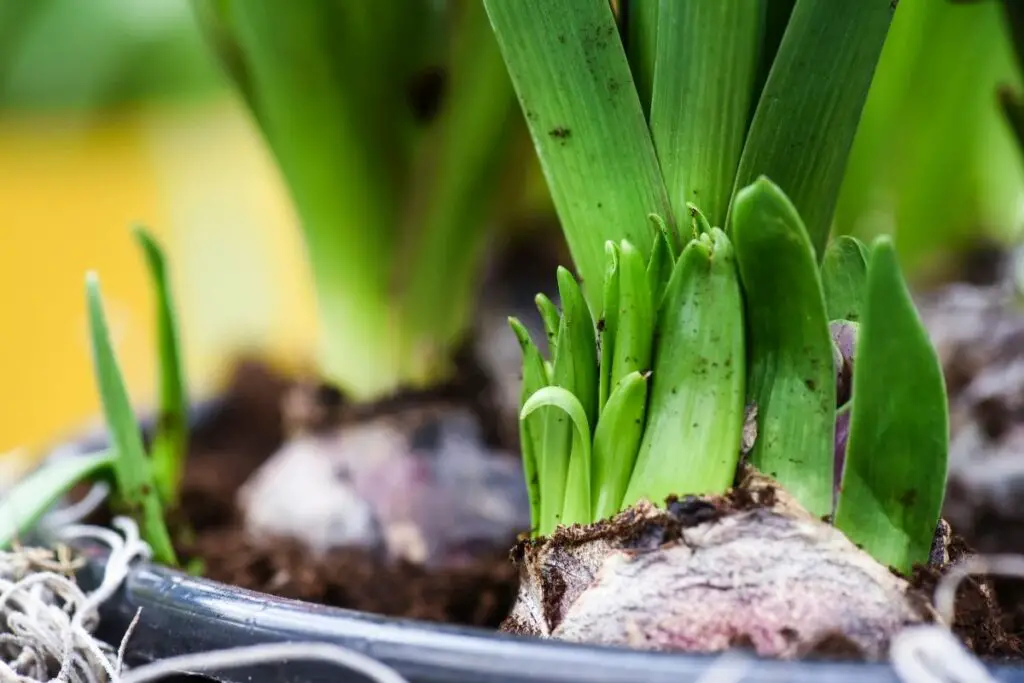
Just like tulips spread from both bulbs and seeds, similarly, the tulips will also be propagated by both. Bulbs mainly propagate the tulips.
Though the tulips can be propagated successfully by seeds, they will take years to grow. Most gardeners avoid germination. Still, we will share both propagation methods for you to try both.
Propagating from bulbs is a straightforward process. By doing it right away at the right time, you will be able to enjoy spring blooms every year.
Autumn is the best season for propagating tulips. When you dig up the bulbs after 3 to 4 years, you will find that the main bulb has grown primary bulbs, called daughter bulbs.
There will be many small secondary bulbs that are yet to mature enough for blooming. The primary bulb is ready to bloom for the following year.
Divide the bulbs from the plant’s base. You can plant both the primary and secondary bulbs. The latter will take some years to bloom, whereas the former will bloom quickly.
Select a planting location once the soil temperature is below 55°F. The site should receive sufficient sunlight.
The soil bed must be well-drained and fertile. Add a layer of compost to ensure it. Plant the bulbs 20 cm deep in the soil and 4 to 5 inches apart. Water the bulbs very well.
Propagating by seeds is very uncommon nowadays. Everyone wants quick results now. Still, one experiment will help you to get accustomed to the process.
Tulips hybridize easily, and these seeds produce flowers that don’t appear like their parent. Moreover, some hybrids don’t even remain perennials.
When the tulip flower starts dying, don’t deadhead. They will go to seeds once dead. Collect the seeds when the seedpods will become dry and turn brown.
The seeds will need storing in the fridge during summers for good germination. Use a plastic bag with a moist paper towel and store the seeds.
Begin seeds in autumn. It is best to start in pots to manipulate their environment. Take a 6-inch container having holes at the bottom and good potting soil.
Plant the seeds in the soil ½ inch deep. Keep a space of a couple of inches in between them. Water them thoroughly to moisten the soil. Don’t overwater.
In winters, keep the pot outside under partial shade. Keep checking the moisture level and water when the soil goes dry. When the temperature goes around 60°F, you will see them sprouting out.
It will take nearly 5-7 years to flower. Let the seedlings grow in a pot for 1-2 years. By this time, they will have bulbs. Once they produce bulbs, transplant them outdoors in an ideal planting site during the second year’s fall.
Tulip toxicity
The tulip bulbs, stems, and flowers are toxic to humans and pets like cats and dogs.
After ingestion, it will cause vomiting, hyper-salivation, depression, diarrhea, skin allergies, and nail brittleness. They are more dangerous for pets and can even kill them.
However, on the other hand, these bulbs and flowers are loved by bugs, rodents, and deer.
Also read: Are Tulips Toxic To Pets? (Dogs, Cats, Small Animals)
Tulip pests and diseases
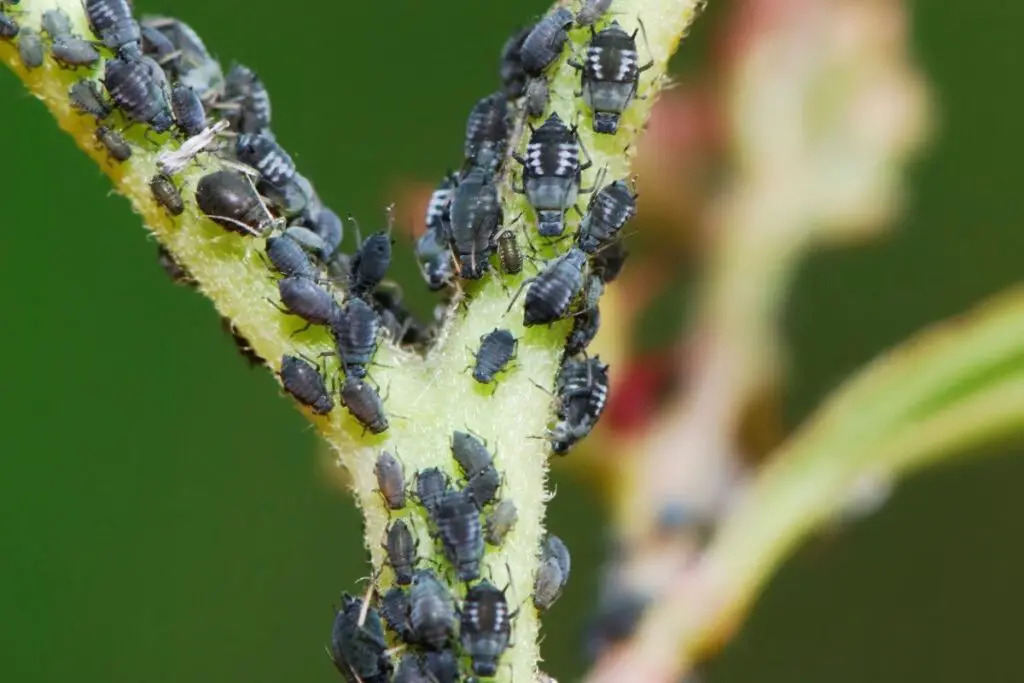
Like other plants, tulips are also loved by bugs like aphids, spider mites and bulb mites, pests like rabbits, rodents, and deer.
Aphids: Aphids are tiny delicate-bodied, light green colored bugs, invisible with naked eyes. They stay primarily under the leaves. They suck out all the saps from the plant. They also carry a Tulip-breaking virus.
Though you can manage a small infestation, a vast infestation needs thorough treatment. In a considerable infection, you don’t have much option than to kill all.
When your leaves have a sticky substance on leaves, it indicates aphid infestation.
Mites: Two types of mites are found in the tulip, one is the spider mites, which suck out saps like aphids, and another is bulb mites, found in bulbs. Spider mites, resembling spiders, feed on the leaves, stems, and flowers.
You will find fine web lines and black moving dots on the tulip leaves.
Bulb mites feed on the bulbs. They infest them either in storage or after they are planted.
They are very tiny, white-colored, and stay under the ground. Bulb mites infest rotted bulbs and like damp conditions.
Slugs: These remain underground. At night, the slugs come out and feed on the leaves. Due to damaged leaves, the bulbs fail to get enough energy from them.
Due to prolonged damp conditions, they target your tulip garden bed under garden debris.
Caterpillar and larvae: The larvae of the bulb flies feed on the bulbs. They make the leaves weak and reduce growth. These larvae look yellow or grey, like maggots.
The ideal way to prevent this is to examine the bulbs before buying or planting.
Also read: Bugs On Tulips: (Common Pests, Identification+How To Get Rid)
How to get rid of bugs?
Keep the soil healthy. Avoid overwatering or over-fertilizing. You can add a layer of compost or mulch to increase fertility and keep bugs at bay. Stop frequent disturbance in the soil.
Use natural predators like ladybugs. They will love to feed on the aphids and won’t even harm your plant.
Trap the bugs. Set a beer can to bury in the ground. The slugs and snails will get attracted by the beer smell, fall into the can and drown. Every morning, empty the can and repeat the process.
Shower the plant very well to remove the bugs from your plant.
Use insecticidal soap solutions and neem oil solutions to remove the bugs from the plant. In the case of insecticidal soap, test in a small portion and then move forward.
Animal pests
Rabbits: They love to feed on the whole plant and even bulbs if too hungry. The diagonal biting style indicates that rabbits attacked your garden. They like leafy vegetables.
So, to stop them from eating your tulips, plant many vegetable plants along with tulips. You can plant other plants like daffodils, ornamental onions, or sage to deter them.
Rodents: Squirrels, chipmunks, rats, and mice will enjoy munching your tulip bulb and plant. They will dig up the bulbs to eat them. Use a bird net in your garden to stop them from reaching your plant.
Try to change the taste or smell around your plant by using materials containing thiram pr Bittrex, methyl nonyl ketone crystals, mothballs, or coyote urine.
These will make sure no rodents attack your garden. Try creating some physical barriers.
Deer: They will munch up the tulip leaves, stems, and flowers. Once they find taste in your garden, keeping them away is hard.
Create a physical barrier around your garden. Use Liquid Fence to keep them away.
Spray cayenne pepper to avert them. You can plant companions having strong smells like daffodils, poppies, peonies, or foxgloves.
Diseases
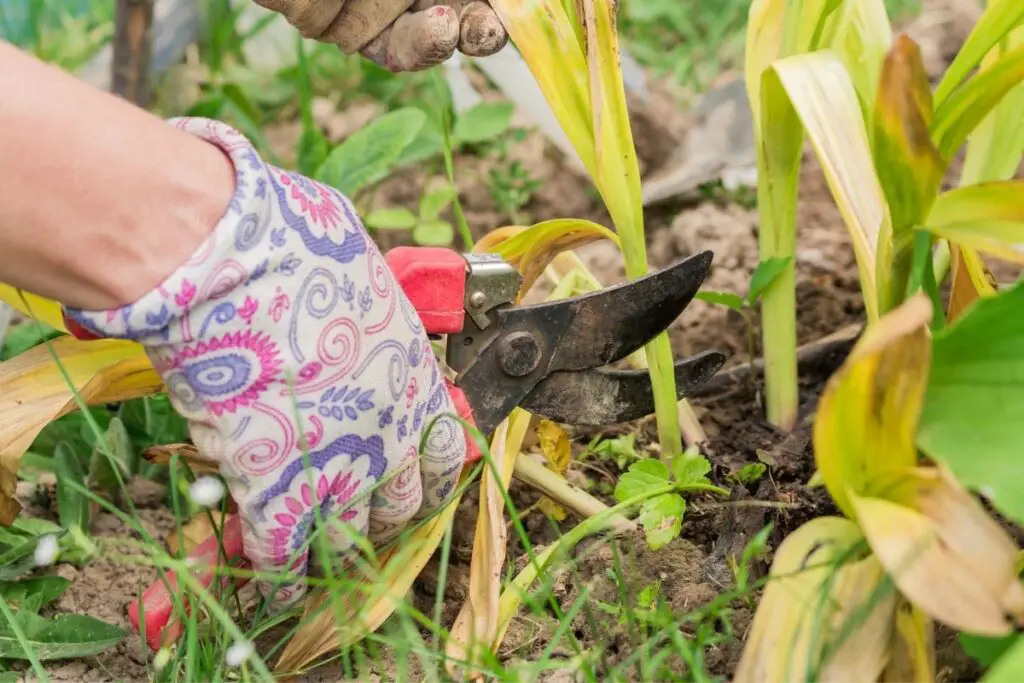
Many diseases will attack the tulips and rot the bulbs in favorable conditions. The most common situations are prolonged damp conditions, incredibly moist, and high humid conditions.
Some diseases in tulips are:
Tulip fire(Botrytis): This is found only in tulips. The leaves lose their color, turn distorted, and flowers get scorched. The flowers will have spots that gradually turn moldy over time, and the plant will rot and die.
Bacterial soft rot and other rots: Rots will take place whenever damp conditions. First, water-soaked spots will be seen on the leaves and stems.
These will slowly turn soft and mushy, then smelly. For this, there is barely any treatment. You have to discard the bulbs.
Tulip breaking virus(TVB): These are carried by aphids. The flowers have stripes, and this virus intensifies the bloom color.
A red tulip turns blood-red. Most growers don’t fix it due to their color change gene. But you must fix this problem. You must destroy the bulbs; first, the leaves get deformed and then die.
The way to fix these diseases is fungicides. If the infection is less, dig up the bulbs and soak them in warm water and fungicide solution.
If the infestation is too much, discarding the bulb is the only option to stop it from further spreading.
For preventing:
- Examine the bulbs before you plant them.
- Keep the garden clean.
- Avoid planting in areas where rot took place once.
- Disinfect garden tools.
- Some rots happen due to moist and humid weather. So avoid planting bulbs in such a climate.
- Avoid saturated locations.
Tulip leaf problems
Tulips face many other problems besides pests and diseases – prematurely yellow leaves, drooping leaves, and purple leaves.
Premature yellow leaves
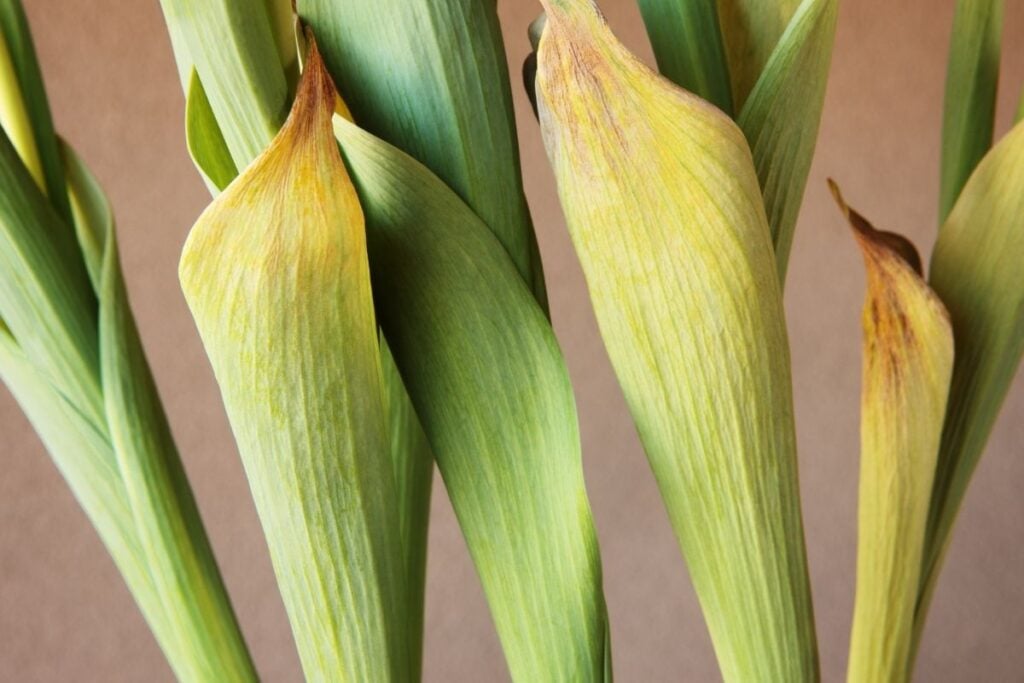
A lot of reasons can cause yellow leaves in tulips. Natural death is expected.
Other reasons can be high alkaline levels, pests and diseases, nutrient deficiency, inadequate watering, drainage and sunlight, over-saturated soil, and shallow planting.
By the time you see yellow leaves, the problems are already there.
To fix the issues, identify the precise reason and give the same treatment. For example, if the problem is alkalinity, do a soil test and fix it using wood ash or limestone powder.
Also read: Why Are My Tulips Turning Yellow? (Possible Problems+Solution)
Purple leaves
The common reason is a phosphorus deficiency. Send your soil for a test before trying anything. It is not always low phosphorus. Maybe the soil is having a problem absorbing it.
Difficulty in absorption happens due to cold and wet soil, which is solved once the weather is resolved. High iron level is another reason for which phosphorus is not absorbed well.
Casually adding high phosphorus fertilizer pollutes the soil. Test the soil and then take action.
For these same reasons, more or less, the tulips keep dying. So, fix the problem initially to revive your precious tulips back to normal health.
Also read: Why Are My Tulips Turning Purple? (Possible Problem+Solution)
Droopy leaves
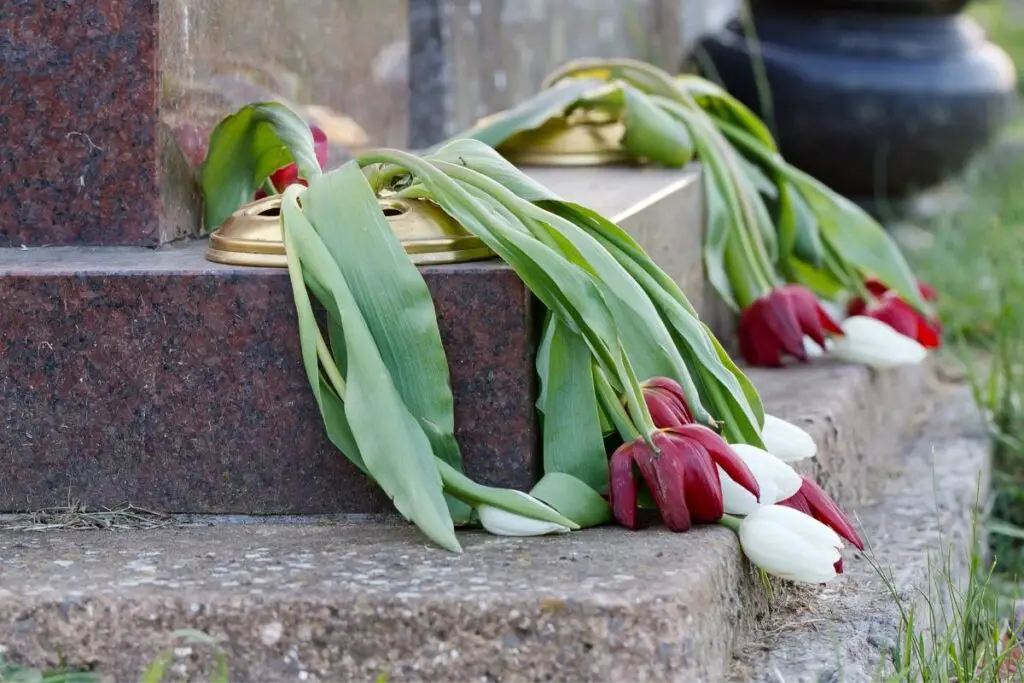
When tulips get droopy, the first strike is dehydration. Tulips don’t need much water, but they need to remain moist.
Other reasons include:
- Light and warmth (because tulips are heliotropic and photonastic plants).
- Sudden temperature change.
- Nutrient deficiency.
- Pests and diseases.
The drooping due to light and warmth is natural. They move according to sunlight. For temperature change, you can protect the plants by adding mulch to keep the soil cool at least.
Create a shelter to protect from the harsh sun. Plant the bulbs in the fall, not early fall.
Also read: Why Are My Tulips Drooping? (Possible Problems+Solution)
Care tips in brief
To enjoy tulips every spring, create an ideal environment to help them thrive. Below, I summed up the basics in brief:
- Make sure the tulips get 6 hours of sun daily.
- Avoid overwatering and watering in summer. Only use 1-inch of water per week.
- The soil should be porous and fertile.
- Add a layer of mulch during planting. Fertilize once when plants sprout and once when the flower dies.
- They have a temperature tolerance of 55-65°F.
- Pinch the flowers after they die. Let the bulbs stay in-ground to spread, provided your region has hardiness zones 4-5. Else, store them to replant in the fall.
- You can propagate them both by bulbs and seeds. Also, try planting some companions like daffodils, sage, alliums, hyacinths, etc.
- Examine bulbs before buying. Discard the bad bulbs to avoid fungal diseases.
Source: Wikipedia, North Dakota Stae University, The Royal Horticultural Society.
